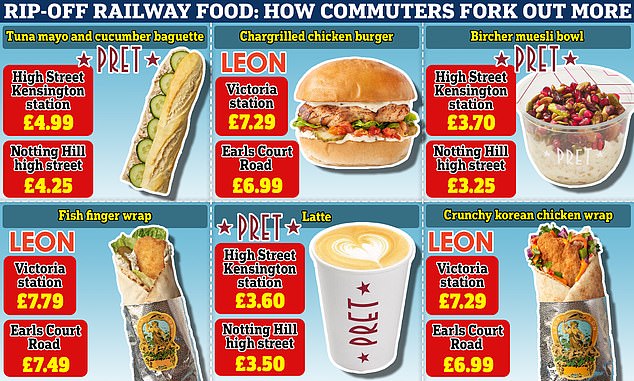Commuters are being hit in the pocket for their morning coffee or lunchtime baguette if they buy from an eatery based at the station – whereas shoppers using high street branches are paying less.
A new report by the The Office of Rail and Road (ORR) has revealed that travellers are forking out around 10% more when they opt for an on-the-go train station lunch.
The watchdog found that on average, popular chains within the stations were charging premiums of up to 34% on food and drinks, compared to their stores elsewhere.

Revealed: Some of the price differences between train station outlets and their high street equivalents
A total of 2,367 rail stations in Britain were investigated, nearly all of which are owned by Network Rail and operated by Train Operated Companies (TOCs) via leasehold agreements between them.
Almost half of the stations that offer catering (47%) had just one outlet, eliminating choice for travellers in a rush.
The findings by the regulator investigating station catering suggest the lack of competition means the market is ‘not working as effectively as it should be’ – leading to poor value for customers.
One long-distance Train Operator Company told regulators that a 2022 survey revealed around 80% of its passengers consume food and drink at the station or on the train, and of these passengers around 70% purchase at the station or on the train.
The report also states that a response submitted by one major operating group said that ‘Convenience is a decisive factor.
‘Customers are less likely to venture far from the station to acquire cheaper catering for fear of missing their train or an important service announcement unless they are familiar with the surrounding area.’.
They also sent a mystery shopper out to try it for themselves – this suggested that that 11 out of the 13 outlets charged a price premium in rail compared to the high street – the premium ranged from 1% to +34%.
Next, they calculated an average all-outlets premium for two products only, the lowest priced bottle of water on sale and a 500ml bottle of branded cola – it revealed a very similar average rail premium (compared to the high-street) of 10%.
We headed out to see for ourselves, and found that almost everything was more expensive at Pret’s High Street Kensington station branch, than its Notting Hill high street equivalent.
The tuna mayo and cucumber baguette is just £4.25 on the high street, but £4.99 in the station – 74p more expensive.
Meanwhile, the Bircher muesli bowl was £3.70 in the station and just £3.25 on the high street.
A latte would set you back 10p more on your commute, £3.80 rather than £3.50 and a ham and cheese sandwich would be 44p more expensive.


Meanwhile, the Bircher muesli bowl was £3.70 (LEFT) in the station and just £3.25 on the high street (RIGHT)


LEON’s Chargrilled chicken burger is also more costly inside Victoria station (LEFT) compared to outside (RIGHT) – £7.29 rather than £6.99


The tuna mayo and cucumber baguette is just £4.25 on the high street (LEFT), but £4.99 in the station (RIGHT)- 74p more expensive
LEON’s Chargrilled chicken burger is also more costly inside Victoria station compared to outside – £7.29 rather than £6.99.
The chains fish finger wrap is £7.79, compared to £7.49 on the high street and the crunch Korean wrap is £7.29, up from £6.99.
However, some eateries prices did remain the same, with Café Nero’s prices in High Street Kensington station matching those outside.
GAILS also had no changes made to their prices in the same station against the ones in their Balham branch.
Will Godfrey, the ORR’s Director of Economics, Finance and Markets, said: ‘The railway station catering market isn’t working as effectively as it should be. More competition between companies to work at stations would bring real benefits to passengers and taxpayers.
‘Because money earned from leases at stations ultimately makes its way back to those who work railway stations and infrastructure, this is money that could be invested in improving services for passengers or reducing the need for taxpayer uphold.
‘We will now work with the industry on the best way forward and will make recommendations on how the market needs to change, with the ultimate goal of improving value and outcomes for customers and funders of the railway.’



